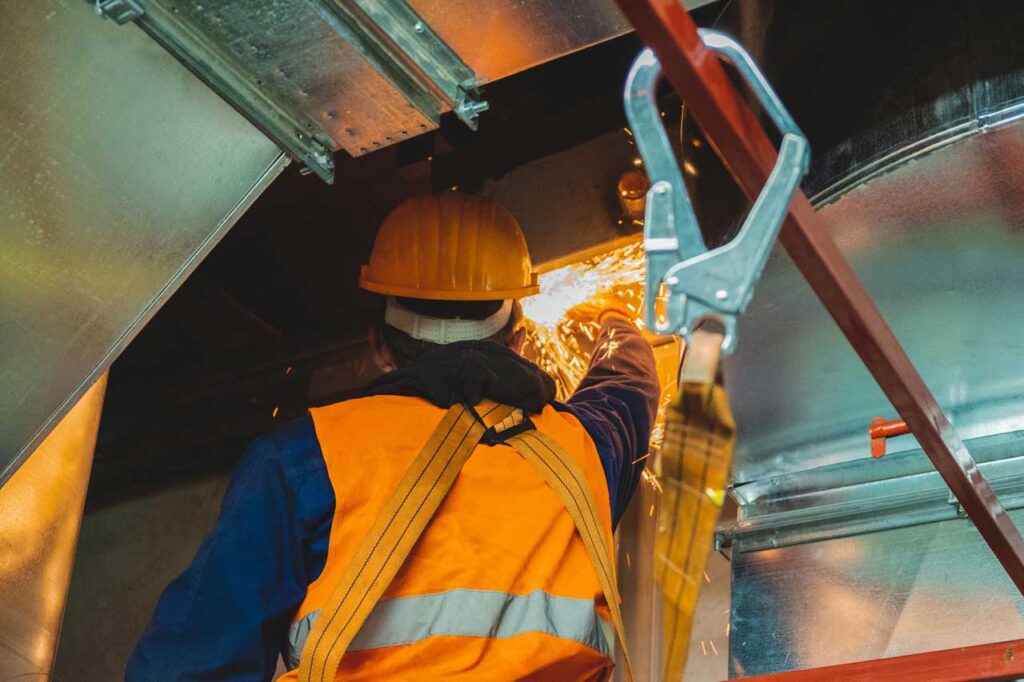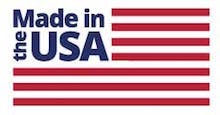Highlighting OTEX’s recent awarding of a second patent for revolutionary Leading-edge webbing (for Fall Protection Devices), the below is a reposting of a blog from last year.
Narrow Fabrics for Fall Protection
Working from heights is a necessary requirement for many jobs and many industries. As such, mitigating the risks associated with these tasks is a priority for both worker and employer. However, the standards and related protective equipment have been, and continue to be, evolving. Prior to the establishment of the Occupational Safety and Health Administration (OSHA) in 1970, employers were not held accountable for creating and maintaining safe working conditions for their employees. At most, employers would typically post signage to delineate a fall risk area or hazardous environments, but by and large, employees were expected to be responsible for their own safety. Fortunately, soon after OSHA was formed, new standards, rules, incentives, and consequences were put in place to motivate employers to address potential fall hazards. This not only dramatically reduced the number of fall-related workplace accidents, but spawned what has become a thriving industry in the engineering and manufacturing of fall-protection equipment.
The History of Fall Protection and Related Standards
The Occupational Safety and Health Administration (OSHA) is a division of the United States Department of Labor that regulates safe working conditions for employees. During the 1970s and 1980s, OSHA began to develop and enforce fall protection standards for industries such as construction, mining, transportation, and manufacturing. OSHA’s involvement in these industries changed employers’ attitudes regarding fall safety. OSHA conducted unannounced inspections of workplaces, and failure to meet their standards gave new incentives for employees to provide appropriate safety protocols. Expensive fines mounted for employers who were noncompliant, and additionally, employers’ litigation costs from fall-related injuries increased as employees began to advocate for their rights to safe working conditions. Changes resulted throughout the construction industry to incorporate passive (guardrails and gates) and active (ropes and body harnesses) fall protection systems for employees.
In 1994, OSHA instituted the Subpart M Fall Protection Standard for construction workplaces and their different needs. The standard applies to employees working at a height of 6 feet or higher. Subpart M covers protection from falling objects, falls from tripping over holes, falling through holes, and protection while working around dangerous equipment without regard for height. Employers are instructed to use fall protection systems such as guardrails, safety nets, or personal fall arrest systems.
Fall safety equipment is always evolving, and OSHA continually collaborates with employers in the construction industry to advocate for employee safety at workplaces. Advancements of materials and technology have vastly improved fall protection systems and have resulted in modified safety standards. With the oversight of OSHA, employers now take a proactive approach toward safety precautions by providing fall prevention equipment and safety training to all employees.
The Evolution of Fall Protection Systems
It was not so long ago that construction workers, and other employees, whose jobs required them to risk performing at heights, had little, or no fall protection equipment. Fortunately, all that has changed.
The “body belt” was one of the earliest versions of a personal fall arrest system, inspired by similar equipment worn by rock-climbers. Body belts were the standard fall protection system of the 1920s, worn loosely around the waists of employees working at extreme heights. The use of safety lanyards was added to the body belt during the 1970s. By securing the body belt to two lanyards, the system achieved added security. A “tie-off system” ensured that if one lanyard broke the other lanyard would remain intact to arrest a fall. Body belts were cumbersome, and employees thought tying and untying their safety lanyards was inefficient. The most significant drawback to the body belt was the inability to protect the employee during a fall unless the employee fell “correctly.”
Fortunately, starting in the 1940s the use of safety harnesses versus body belts offered a better option of fall protection equipment. Manufacturers were inspired by similar equipment worn by military paratroopers. Early harnesses were bulky and complicated but, the harnesses’ capability to arrest a fall was a vast improvement from the body belt. Advancements of materials and design continued throughout the 1990s, when the full-body harnesses became standard personal fall protection equipment.
Modern materials provided manufacturers with lightweight, durable solutions for improving the wearability and effectiveness of fall protection harnesses.
Today’s fall protection harnesses and safety lanyards meet strict OSHA standards and rigorous industry-specific requirements. Personal fall protection equipment is constructed with state-of-the-art materials. Safety harnesses are comfortable enough to wear for an entire workday and safe enough to prevent serious injury. Employees can easily adjust full-body harnesses to fit to size. Personal fall protection equipment does not impede employees’ progress yet upholds fall safety at the workplace to the highest standard.
Narrow Fabrics for Fall Protection
High-performance narrow textiles are utilized in a variety of fall protection products and have played a pivotal role in the evolution and improvement of worker safety equipment. Key product categories include:
Full Body Harnesses
A full-body harness is the single most important equipment choice you can make for your crew. Fall protection harnesses provide comfort and confidence, and directly affect the user’s productivity. They come in general varieties that can be used in many applications or may be specialized for specific uses within different industries.
Fall Protection Lanyards
A fall protection lanyard (or safety lanyard) is a set length of rope, webbing, or wire rope. Designs often incorporate an internal or external shock absorbing feature. Shock-absorbing lanyards are a bit more versatile and can be used for purposes such as fall arrest, work positioning, or restraint. Non-shock absorbing lanyards can be used for restraint only. Safety lanyards are connected to a fixed anchor point, which can limit the wearer’s work radius. They tend to be less expensive than SRLs, so for smaller jobs or for the budget-conscious manager, they may be a good choice.
Self-Retracting Lifelines (SRL)
Self-retracting lifelines are designed using webbing, wire rope, or a cable that automatically retracts into a housing unit, never allowing for any slack in the line. Like lanyards, SRLs are generally attached to the back of a full-body harness, but are longer than lanyards – permitting a larger working radius, even when using a fixed anchor point, which is typically overhead. A breaking mechanism inside the housing unit will arrest a worker’s fall, much like a car seatbelt. A self-retractable lifeline can be heavier than a safety lanyard, and for those watching their bottom line, tends to be pricier. That said, they offer more mobility and fast-acting fall arrest capability.
Leading Edge
There are many types and grades of lifelines and lanyards, engineered to protect workers in a great variety of environments and scenarios. These can be produced from numerous materials and there are well-defined standards and tests for ensuring their mission-critical performance when deployed.
Currently, the most rigorous of these tests/standards is the Z359.14-2021 Leading Edge Fall Protection standard, developed (and updated) by the American National Standards Institute (ANSI). The performance test – which includes dropping a +300 pound weight and allowing the attached lifeline to be dragged across a 1 millimeter steel blade, set at a 45 degree angle – is meant to simulate the most dangerous and challenging falling accidents/scenarios.
Historically, it was only steel cable lifelines that were capable to passing the Leading Edge standards, but – because the SRLs containing these heavy cables were so heavy – putting great strain on workers having to wear these units all day – there were many engineers and manufacturers trying to come up with a textile (webbing) SRL lifeline that was both lightweight and durable enough to pass the ANSI standard.
In September of 2017, OTEX became the first to accomplish this innovation challenge with its patent-pending (now Patented: 2024) Sentry LifeLine® webbing. This unique high-performance fall-protection webbing has been the critical component for numerous Leading Edge SRLs from multiple top Fall-protection equipment manufacturers.
Additionally, in April of 2022, OTEX was awarded a patent for a variation of our Leading Edge SRL webbing, designed to also protect wearers of LE SRLs from electrical arc flash. A key performance criteria for utility workers.
When it comes to producing the finest specialty narrow textiles for the Fall Protection sector, the OTEX staff of R&D Specialists, Quality Assurance experts, and Sales/Customer Service representatives, are as excited and committed to engineering new products to reach new levels of performance, as we are with all the demanding industries we serve.
If you would like to learn more about these, or other OTEX webbings, elastics, tapes, trims, tubes, and/or E-textiles we offer. Please contact our sales staff anytime. We’d love to hear about your unique needs and goals.



